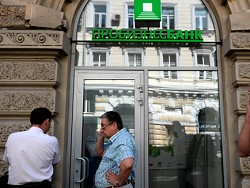
The procedure of bail-in is not a Russian invention and is not an attempt to Rob a place, but rather the implementation is quite flexible and world-known mechanism. But the devil, as usual, sits in the details. Now the discussion has just begun, and there is a noticeable difference in the positions of the Ministry of Finance and the Central Bank, and many questions arise for both
In recent weeks, the Russian financial authorities began to actively discuss the possibility that troubled banks were saved, not only the state but their major contributors, there is the possibility to introduce in Russia the procedure of bail-in. The purpose of these legal innovations is to reduce to the state and its agents, the cost of rehabilitation of troubled banks. To make the cost of the Bank bailout, it was possible to share not only with its shareholders but also its creditors who were required to submit, where to invest, but for whatever reason became blind in the process.
A few years ago everything was arranged quite simply. If the Bank has revoked the license, payment is received only physical persons within the limits of Deposit insurance. And all other lenders (major contributors, legal entity with a settlement account, the bondholders) went to bankruptcy and received a mere penny. If the Bank decided to sanitize, then after a period of suspension of payments and large depositors, and legal persons found themselves clients of higher quality (due to government support) of the Bank. The hole in the banks ‘ assets (bad loans, fictitious securities) have been covered by funds allocated for sanitation.
However, this procedure is not particularly encouraged clients to look after themselves. Constantly had situations when the need to help all the depositors (legal and natural persons) dramatically increases the cost of rescue of problem banks and did the license revocation though, and disadvantageous to the depositors, but the most reasonable for the authorities option.
Bail-in is a forced conversion of the unsecured claims of creditors of the third turn in the subordinated deposits or the Bank’s authorized capital. Something like an intermediate option between revoking a license (all is lost) and sanitation (problems with the Central Bank and the Bank rehabilitation, the clients “in house”). This option is usually formed in the mode of more or less manual control.
Bail-in rather actively used in the USA, as well as in the reorganization of banks in Cyprus in 2013. In this mode (after the introduction of the Basel standards) are the owners of subordinated Eurobonds – falling quality standards of the Bank’s capital below certain levels or when administered in the Bank rehabilitation bonds are automatically deducted.
In the process of reorganization of the Bank “trust” under the roller of bail-in were individual owners of derivative securities that were offered under the guise of “almost” Deposit products. Now go to the courts on the legality of the sale of such securities to unqualified investors. But in General, the mechanism of bail-in solves the issue of fairness and helps not to hang all of the losses only on shareholders and regulators.
In Russia the individual elements of bail-in is already used in trial mode with voluntary-compulsory consent of the parties. In recent months there have been two cases, when choosing between the revocation of the license (is almost nothing, but it is now) or the conversion of deposits and account balances in uninsured deposits (to get something, maybe all, but much later) large corporate clients agreed to the conversion and the CB made a choice in favor of a lower cost of rehabilitation.
With the collapse of the Bank “Tavrichesky” Lenenergo agreed to defer payment for 20 years, and during the rescue of the Fundservicebank Roscosmos agreed on a ten-year postponement if sufficient market interest rates during the period of readjustment. For the Central Bank and Agency on insurance of contributions (ASV) reduced sanitation is additionally advantageous in that it reduces the pressure on the Deposit insurance Fund. He now pays the insurance by loans from the Central Bank’s reserve Fund, accumulated since 2005, has shoaled to mid-2015, and the proceeds from the sale of bad assets do not cover the flows of payments related to revocation of licenses.
Therefore, the new procedure is not a Russian invention and is not an attempt to Rob a place, but rather the implementation is quite flexible and world-known mechanism. But the devil, as usual, sits in the details. Now the discussion has just begun, and there is a noticeable difference in the positions of the Ministry of Finance and the Central Bank.
According to Deputy Minister of Finance Alexey Moiseyev, ultra-large deposits of private persons – from 100 million rubles for the financial rehabilitation of the Bank the Agency on insurance of contributions can be forcibly converted into equity capital of the Bank. From the point of view of the Ministry of Finance individuals with such large deposits do not differ from legal entities and should rejoice in the fact that the Bank will sanitize and they get to keep during the bankruptcy process.
However, the head of the Central Bank Elvira Nabiullina believes that the process of bail-in should be offered the choice between a subordinated Deposit (subject to cancellation by analogy with Eurobonds when the deterioration of the Bank) and the acquisition of shares of the Bank, which in some cases can be interesting for customers. The Central Bank believes that smaller depositors (specific number not stated) should be subjected to prolonged freezing of the deposits.
Here, first of all, strange clipping level at which deposits will be converted into subordinated deposits or shares. It’s possible that mega will be announced the Deposit of over 50 million or even 10 million rubles, which will affect considerably more businesses and citizens. Moreover, when the deterioration of the situation in the banking system, it is possible that all deposits over the insurance limit will be subject to shrinkage.
In the reorganization Bank of Cyprus 47.5% of deposits over 100 thousand Euro (insured limit), were exchanged for shares. It was clearly not mega investments, and such examples will be contagious for our controller.
No clear answer to this and many other questions. Will there be such a compulsion to treat the uninsured deposits and accounts of legal entities? Will there be exemptions for NGOs and social structures? As will be set rate on subordinated deposits? As will be choice between a subordinated Deposit or shares, as well as the calculation of the coefficients? All of these are essential for Bank customers, the issues will be resolved in the legislative process of registration and preparation of the regulatory framework of the Central Bank and the Deposit insurance Agency, which will take time and will require extensive expert discussion.








